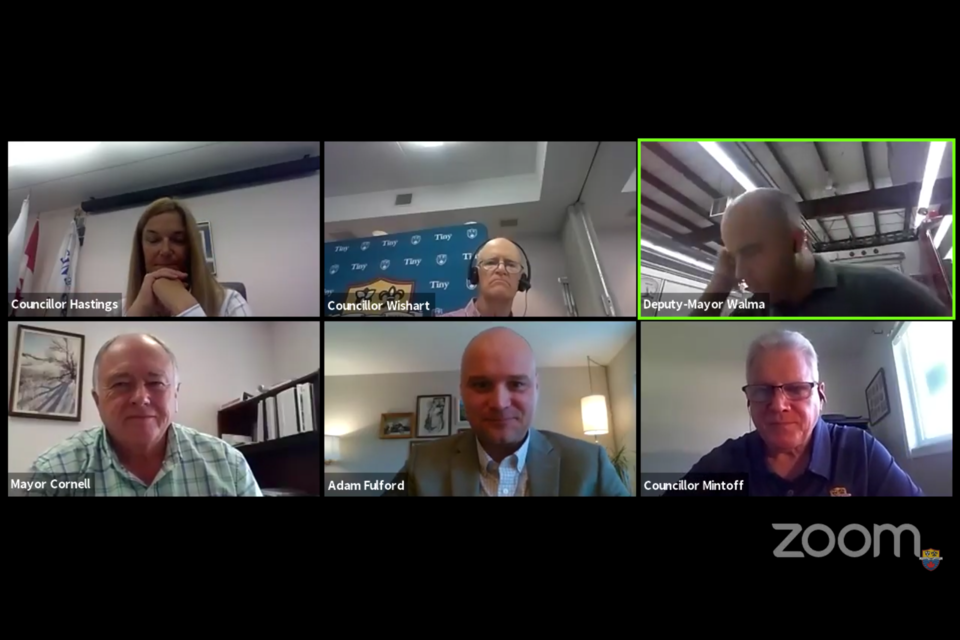Tiny councillors have endorsed plans to build two mammoth telecommunications towers in Wyevale and Wyebridge.
The tower proposed for the firehall in Wyevale would be 60.5 metres tall; a height that will require it to be lit up, according to Transport Canada standards. The Wyebridge Community Centre is the chosen site for the second tower and the proposed height council endorsed for that location is 50.1 metres, which will also require lighting.
"Nothing is definitive until Transport Canada completes the process," Adam Fulford, director land services, CanACRE Ltd. "What we would normally be looking at would be a constant white, medium-intensity light during the day. It could also be a strobe. At night time, it will be a red, medium-intensity stobe. Given at these heights, it won't be two layers of lighting. It's likely one layer, which means at the top of the tower."
Council was united on the need for the taller towers given the increase in service it would provide to the two communities.
According to Fulford's presentation, for Wyevale a height of 46.8 metres would increase coverage for up to 480 buildings, whereas a 60.5 metres tall tower would provide coverage for up to 500 buildings and up to 40 more people in its district service area (DSA).
In Wyebridge, a 35 metre-tall tower would increase capacity for up to 130 buildings, whereas a 52.1 metre-tall tower would increase the capacity for up to 150 buildings and 35 people in its DSA.
"DSA is the number of people, right?" asked Deputy Mayor Steffen Walma.
Fulford said that is correct.
"I appreciate the metric," Walma continued, "but I just wanted to critique it from my point of view. It's not just the members in buildings that are directly affected, in a rural community we also have to look at coverage area, as in land. From an agricultural benefit, all those surroundings lands are a lot of farm land and broadband capacity is huge for our farming operations. I just wanted to lend my support for the taller tower."
Where a 6% increase in capacity for the Wyevale location may not seem substantial, said Fulford, the company is not looking to service farm fields but the people who are using those fields.
"But I'm right along with you," he said. "We believe we should be going for the higher height, so I don't disagree with your assessment at all."
Mayor George Cornell asked if this increase in capacity would be typical for the proposed height.
"I would have expected a little bit higher, personally," said Fulford. "This proposal is servicing so many people that even a change of 40 buildings, which is not insignificant, may not appear to be as significant as it really is because we're servicing so many more people at this height."
Since both towers are of a height that would require lighting by Transport Canada standards, staff pointed out a potential issue residents in the area may have due to the township's dark skies policy.
"We want to keep the tower at a specific height to keep in line with that," said Shawn Persaud, director of planning and development.
"My only concern with that is if we get 'x' amount of residents that are all for the low height and 'x' amount that want full coverage, we'll be caught in a place where we have to weigh those two things. From a staff perspective, my thought was to go with a higher height and then go for public consultation by making it very clear that it will require lighting."
Coun. Tony Mintoff thought council should endorse the taller height for the "greater good."
"I think it's important that council provide their own recommendation regardless of which way we go," he said. "I don't see any harm in providing the two-option model as long as we have fulsome information about the pros and cons of each of them.
"At the end of the day, I think we need to look at what's for the greater good here. Because a few people might be upset because of their dark sky interest, I would hate to see that a number of people lack a fundamental, rudimentary service, like cell-service in this day and age. My view is if you don't want to look at where the light is, turn your head and you won't see the light."
With council's support, Fulford said, the consultation should take upto 45 days before a land-use agreement is signed and the project can begin, likely next spring.
Cornell asked how Fulford planned on conducting a public consultation session given the lack of connectivity in that area.
"It is a bit of a catch-22," said Fulford, noting the plan was to send mailouts to residents in that area, giving them multiple options to respond with their feedback during the three-week consultation period.
"Once that is complete, we come to council with a summary and comments and staff will produce a report to council," said Fulford. "We understand the urgency of bringing these networks to the area."
